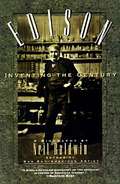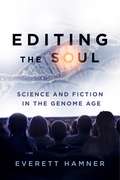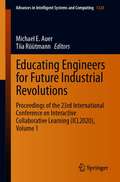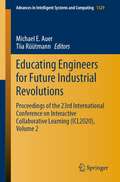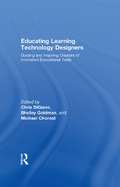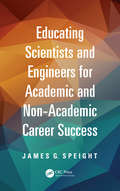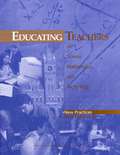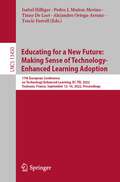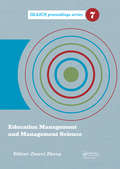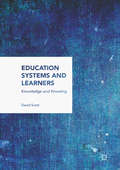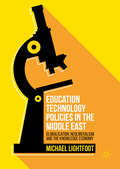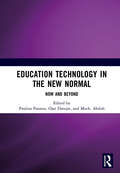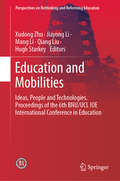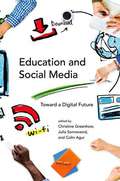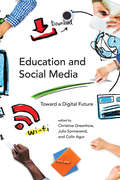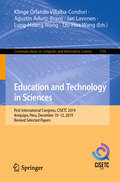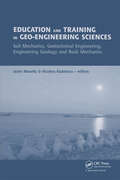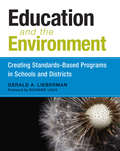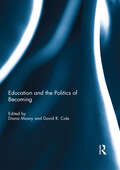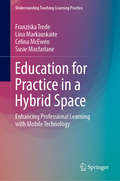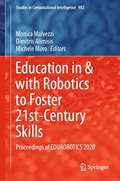- Table View
- List View
Editing the Soul: Science and Fiction in the Genome Age (AnthropoScene)
by Everett HamnerPersonal genome testing, gene editing for life-threatening diseases, synthetic life: once the stuff of science fiction, twentieth- and twenty-first-century advancements blur the lines between scientific narrative and scientific fact. This examination of bioengineering in popular and literary culture shows that the influence of science on science fiction is more reciprocal than we might expect.Looking closely at the work of Margaret Atwood, Richard Powers, and other authors, as well as at film, comics, and serial television such as Orphan Black, Everett Hamner shows how the genome age is transforming both the most commercial and the most sophisticated stories we tell about the core of human personhood. As sublime technologies garner public awareness beyond the genre fiction shelves, they inspire new literary categories like “slipstream” and shape new definitions of the human, the animal, the natural, and the artificial. In turn, what we learn of bioengineering via popular and literary culture prepares the way for its official adoption or restriction—and for additional representations. By imagining the connections between emergent gene testing and editing capacities and long-standing conversations about freedom and determinism, these stories help build a cultural zeitgeist with a sharper, more balanced vision of predisposed agency.A compelling exploration of the interrelationships among science, popular culture, and self, Editing the Soul sheds vital light on what the genome age means to us, and what’s to come.
Editing the Soul: Science and Fiction in the Genome Age (AnthropoScene: The SLSA Book Series #2)
by Everett HamnerPersonal genome testing, gene editing for life-threatening diseases, synthetic life: once the stuff of science fiction, twentieth- and twenty-first-century advancements blur the lines between scientific narrative and scientific fact. This examination of bioengineering in popular and literary culture shows that the influence of science on science fiction is more reciprocal than we might expect.Looking closely at the work of Margaret Atwood, Richard Powers, and other authors, as well as at film, comics, and serial television such as Orphan Black, Everett Hamner shows how the genome age is transforming both the most commercial and the most sophisticated stories we tell about the core of human personhood. As sublime technologies garner public awareness beyond the genre fiction shelves, they inspire new literary categories like “slipstream” and shape new definitions of the human, the animal, the natural, and the artificial. In turn, what we learn of bioengineering via popular and literary culture prepares the way for its official adoption or restriction—and for additional representations. By imagining the connections between emergent gene testing and editing capacities and long-standing conversations about freedom and determinism, these stories help build a cultural zeitgeist with a sharper, more balanced vision of predisposed agency.A compelling exploration of the interrelationships among science, popular culture, and self, Editing the Soul sheds vital light on what the genome age means to us, and what’s to come.
Edmond Halley: The Many Discoveries of the Most Curious Astronomer Royal
by David K. LoveEdmond Halley is known far and wide thanks largely to the comet bearing his name, the return of which he predicted in 1705. While that discovery would be enough to make the career of any scientist, Halley&’s massive contributions to the fields of astronomy, navigation, geophysics, mathematics, engineering, and actuarial science as a young man and eventually as Astronomer Royal are mostly overlooked. Edmond Halley: The Many Discoveries of the Most Curious Astronomer Royal is a revelatory and deeply researched biography of a man whose defining achievement isn&’t even the half of it.A jack-of-all-trades when it came to scientific reasoning, an all-around academic and workaholic who couldn&’t leave well enough alone, Halley was amazingly productive and prolific. He was behind some of the most groundbreaking discoveries in human history: It was Halley who was the first to accurately plot the stars of the southern hemisphere. He published Isaac Newton&’s Principia, arguably the most important scientific text ever written; translated the works of ancient Greek mathematician Apollonius; captained the ship Paramore on a scientific expedition to plot the Earth&’s magnetic fields; was the first to calculate mortality annuities, creating the foundation for actuarial science; made improvements to the diving bell; surveyed the tides of the English Channel; and began the movement to accurately measure the distance between the Earth and Sun, unlocking the key to determining the distances to the nearest stars.In this incisive and perceptive biography, author David K. Love reveals the boundless mind and endless curiosity of Edmond Halley firmly cementing the legacy of the second Astronomer Royal among the first-rate scientists of his time.
Educating Engineers for Future Industrial Revolutions: Proceedings of the 23rd International Conference on Interactive Collaborative Learning (ICL2020), Volume 1 (Advances in Intelligent Systems and Computing #1328)
by Michael E. Auer Tiia RüütmannThis book contains papers in the fields of collaborative learning, new learning models and applications, project-based learning, game-based education, educational virtual environments, computer-aided language learning (CALL) and teaching best practices.We are currently witnessing a significant transformation in the development of education and especially post-secondary education. To face these challenges, higher education has to find innovative ways to quickly respond to these new needs. There is also pressure by the new situation in regard to the Covid pandemic.These were the aims connected with the 23rd International Conference on Interactive Collaborative Learning (ICL2020), which was held online by University of Technology Tallinn, Estonia from 23 to 25 September 2020. Since its beginning in 1998, this conference is devoted to new approaches in learning with a focus on collaborative learning. Nowadays the ICL conferences are a forum of the exchange of relevant trends and research results as well as the presentation of practical experiences in Learning and Engineering Pedagogy. In this way, we try to bridge the gap between ‘pure’ scientific research and the everyday work of educators. Interested readership includes policymakers, academics, educators, researchers in pedagogy and learning theory, school teachers, learning industry, further and continuing education lecturers, etc.
Educating Engineers for Future Industrial Revolutions: Proceedings of the 23rd International Conference on Interactive Collaborative Learning (ICL2020), Volume 2 (Advances in Intelligent Systems and Computing #1329)
by Michael E. Auer Tiia RüütmannThis book contains papers in the fields of engineering pedagogy education, public–private partnership and entrepreneurship education, research in engineering pedagogy, evaluation and outcomes assessment, Internet of Things & online laboratories, IT & knowledge management in education and real-world experiences. We are currently witnessing a significant transformation in the development of education and especially post-secondary education. To face these challenges, higher education has to find innovative ways to quickly respond to these new needs. There is also pressure by the new situation in regard to the Covid pandemic. These were the aims connected with the 23rd International Conference on Interactive Collaborative Learning (ICL2020), which was held online by University of Technology Tallinn, Estonia from 23 to 25 September 2020. Since its beginning in 1998, this conference is devoted to new approaches in learning with a focus on collaborative learning. Nowadays the ICL conferences are a forum of the exchange of relevant trends and research results as well as the presentation of practical experiences in Learning and Engineering Pedagogy. In this way, we try to bridge the gap between ‘pure’ scientific research and the everyday work of educators. Interested readership includes policymakers, academics, educators, researchers in pedagogy and learning theory, school teachers, learning industry, further and continuing education lecturers, etc.
Educating Learning Technology Designers: Guiding and Inspiring Creators of Innovative Educational Tools
by Michael Chorost Shelley Goldman Chris DiGianoWhat knowledge and skills do designers of learning technologies need? What is the best way to train them to create high-quality educational technologies? Distilling the wisdom of expert instructors and designers, this cutting-edge guide offers a clear, accessible balance of theory and practical examples. This cutting-edge guide: synthesizes learning, instructional design, and educational technology perspectives on learning-centered technology — highlighting how interdisciplinary work is driving the fields of the learning sciences and technology design and development offers helpful resources for both faculty and students — including descriptions of a variety of successful courses in learning technology design, examples of student work with commentary by instructors and students, and discussions of "lessons learned" in course development includes a "To the Student" chapter that speaks in plain language about what is exciting and challenging about creating technology for kids Directed to university instructors working with students on developing educational software projects and to managers leading learning technologies development teams, this book is a valuable resource for guiding and inspiring the next generation of designers of learning technologies.
Educating Scientists and Engineers for Academic and Non-Academic Career Success (ISSN)
by James SpeightIn an increasingly technological world, the education of scientists and engineers has become an activity of growing importance. Educating Scientists and Engineers for Academic and Non-Academic Career Success focuses on the structure of the current educational system and describes the transformations needed to ensure the adequate education of future
Educating Teachers of Science, Mathematics, and Technology: New Practices for the New Millenium
by Committee on Science Mathematics Teacher PreparationEach new headline about American students' poor performance in math and science leads to new calls for reform in teaching. Education Teachers of Science, Mathematics, and Technology puts the whole picture together by synthesizing what we know about the quality of math and science teaching, drawing conclusions about why teacher preparation needs reform, and then outlining recommendations for accomplishing the most important goals before us.As a framework for addressing the task, the book advocates partnerships among school districts, colleges, and universities, with contributions from scientists, mathematicians, teacher educators, and teachers. It then looks carefully at the status of the education reform movement and explores the motives for raising the bar for how well teachers teach and how well students learn.Also examined are important issues in teacher professionalism: what teachers should be taught about their subjects, the utility of in-service education, the challenge of program funding, and the merits of credentialing. Professional Development Schools are reviewed and vignettes presented that describe exemplary teacher development practices.
Educating for Creativity within Higher Education: Integration of Research into Media Practice (Creativity, Education and the Arts)
by Susan Kerrigan Phillip McIntyre Janet Fulton Elizabeth Paton Michael MeanyThis book provides innovative insights into how creativity can be taught within higher education. Preparing students for employment in a dynamic set of global creative industries requires those students to not only be resilient and entrepreneurial, but also to be locally focused while being globally aware. Therefore it is imperative that they acquire a thorough understanding of creative processes and practice as they try to keep pace with worldwide digital trends. As the creation of media messages is a fundamental aspect of global creative industries, and that numerous concerns practitioners face are based upon a certain understanding of creativity, the authors propose an exploration of what creativity is in terms of research, and then apply it pedagogically. Drawing on extensive empirical research, the authors pose the thought-provoking question of whether creativity can be taught. This volume will be of interest to both students and scholars of creativity and higher education as well as to creatively-based practitioners more widely.
Educating for a New Future: 17th European Conference on Technology Enhanced Learning, EC-TEL 2022, Toulouse, France, September 12–16, 2022, Proceedings (Lecture Notes in Computer Science #13450)
by Tinne De Laet Isabel Hilliger Alejandro Ortega-Arranz Pedro J. Muñoz-Merino Tracie FarrellThis book constitutes the proceedings of the 17th European Conference on Technology Enhanced Learning, EC-TEL 2022, held in Toulouse, France, in September 2022.The 30 research papers and 31 demo and poster papers presented in this volume were carefully reviewed and selected from 109 submissions. Chapter “Learners’ Strategies in Interactive Sorting Tasks” is available open access under a CC BY 4.0 license.
Education Management and Management Science: Proceedings of the International Conference on Education Management and Management Science (ICEMMS 2014), August 7-8, 2014, Tianjin, China (IRAICS Proceedings)
by Dawei ZhengThis proceedings volume contains selected papers presented at the 2014 International Conference on Education Management and Management Science (ICEMMS 2014), held August 7-8, 2014, in Tianjin, China. The objective of ICEMMS2014 is to provide a platform for researchers, engineers, academicians as well as industrial professionals from all over the wo
Education Systems and Learners
by David ScottThis book explores curricular, teaching and learning practices in schools in England and in higher education institutions, and considers the damaging effects of the Research Excellence Framework (REF) for UK higher education institutions, international comparative assessment systems such as the Programme for International Student Assessment (PISA), and broadly, how educational judgements are now made about educational matters. David Scott criticizes the implementation of neo-liberal policies and practices in education systems round the world, management and control system approaches, and empiricist/positivist research agendas. The book offers an account of a new education model, which is directly in opposition to agendas currently supported by the right of the political spectrum. It will be of interest to teachers and students of education, the education research community, practising and trainee teachers, and education policy makers.
Education Technology Policies in the Middle East
by Michael LightfootThis book explores the potential educational technologies have for transforming education in the Middle East. Although technology has increasingly become a part of classrooms around the globe over recent decades, its application in classrooms in the MENA region remains underused and this book draws on a case study from the Arabian Gulf to examine the beneficial impact technologies have on teaching and learning. The book identifies the many social and cultural pressures that prevent government technology policies to be implemented in the way that the international community would find recognisable and acceptable and how education policy from the Global North is transplanted into a separate context without considering the different requirements. The study seeks to address the ways in which educational technology policy in government schools plays a part in the enactment of education reforms and how government policy aspirations are played out in practice. iv>
Education Technology in the New Normal: Proceedings of the International Symposium on Open, Distance, and E-Learning (ISODEL 2021), Jakarta, Indonesia, 1 – 3 December 2021
by Paulina Pannen Ojat Darojat Moch. AbduhThe proceedings of the International Symposium on Open, Distance, and E-Learning (ISODEL 2021) share ideas, either research results or literature reviews, on distance education, media, and education in the digital era. Some recent issues consist of innovative education in the digital era, new media Industry 4.0, Digital Education Transformation, Character Building, Vocational Education 4.0, and Preserving Future Children Characters and Culture. It is expected that the proceedings will provide new insights to the knowledge and practice of education and education technology research. Therefore, such parties involved in education research such as academics, practitioners, business leaders, and others will benefit from the contents of the proceedings.
Education and Mobilities: Ideas, People and Technologies. Proceedings of the 6th BNU/UCL IOE International Conference in Education (Perspectives on Rethinking and Reforming Education)
by Xudong Zhu Mang Li Qiang Liu Hugh Starkey Jiayong LiThis book gathers selected original papers presented at the Sixth Beijing Normal University - University College London, Institute of Education International Conference in Education, a biennial event organised in partnership between this two universities. Readers will find a wealth of papers and reports on research involving schools and the initial and professional development of teachers, revealing links between research, policy and practice, while also analyzing key themes in education, including public goals and policies, pedagogy, curricula, organisation, resources and technologies, and institutional effectiveness. An essential guide for anyone who wishes to understand the main issues involved in mobilities of ideas, people and technology in the field of education, the book offers an extensive introduction, and can also be used as a resource for empirical and conceptual research into related issues.
Education and Social Media: Toward a Digital Future
by Colin Agur Christine Greenhow Julia SonnevendHow are widely popular social media such as Facebook, Twitter, and Instagram transforming how teachers teach, how kids learn, and the very foundations of education? What controversies surround the integration of social media in students' lives? The past decade has brought increased access to new media, and with this new opportunities and challenges for education. In this book, leading scholars from education, law, communications, sociology, and cultural studies explore the digital transformation now taking place in a variety of educational contexts. The contributors examine such topics as social media usage in schools, online youth communities, and distance learning in developing countries; the disruption of existing educational models of how knowledge is created and shared; privacy; accreditation; and the tension between the new ease of sharing and copyright laws. Case studies examine teaching media in K--12 schools and at universities; tuition-free, open education powered by social media, as practiced by the University of the People; new financial models for higher education; the benefits and challenges of MOOCS (Massive Open Online Courses); social media and teacher education; and the civic and individual advantages of teens' participatory play.ContributorsColin Agur, Jack M. Balkin, Valerie Belair-Gagnon, danah boyd, Nicholas Bramble, David Buckingham, Chris Dede, Benjamin Gleason, Christine Greenhow, Daniel J. H. Greenwood, Jiahang Li, Yite John Lu, Minhtuyen Mai, John Palfrey, Ri Pierce-Grove, Adam Poppe, Shai Reshef, Julia Sonnevend, Mark Warschauer
Education and Social Media: Toward a Digital Future (The John D. and Catherine T. MacArthur Foundation Series on Digital Media and Learning)
by Colin Agur Christine Greenhow Julia SonnevendLeading scholars from a variety of disciplines explore the future of education, including social media usage, new norms of knowledge, privacy, copyright, and MOOCs.How are widely popular social media such as Facebook, Twitter, and Instagram transforming how teachers teach, how kids learn, and the very foundations of education? What controversies surround the integration of social media in students' lives? The past decade has brought increased access to new media, and with this new opportunities and challenges for education. In this book, leading scholars from education, law, communications, sociology, and cultural studies explore the digital transformation now taking place in a variety of educational contexts. The contributors examine such topics as social media usage in schools, online youth communities, and distance learning in developing countries; the disruption of existing educational models of how knowledge is created and shared; privacy; accreditation; and the tension between the new ease of sharing and copyright laws. Case studies examine teaching media in K–12 schools and at universities; tuition-free, open education powered by social media, as practiced by the University of the People; new financial models for higher education; the benefits and challenges of MOOCS (Massive Open Online Courses); social media and teacher education; and the civic and individual advantages of teens' participatory play.ContributorsColin Agur, Jack M. Balkin, Valerie Belair-Gagnon, danah boyd, Nicholas Bramble, David Buckingham, Chris Dede, Benjamin Gleason, Christine Greenhow, Daniel J. H. Greenwood, Jiahang Li, Yite John Lu, Minhtuyen Mai, John Palfrey, Ri Pierce-Grove, Adam Poppe, Shai Reshef, Julia Sonnevend, Mark Warschauer
Education and Technology in Sciences: First International Congress, CISETC 2019, Arequipa, Peru, December 10–12, 2019, Revised Selected Papers (Communications in Computer and Information Science #1191)
by Lung-Hsiang Wong Jari Lavonen Klinge Orlando Villalba-Condori Agustín Aduríz-Bravo Tzu-Hua WangThis book constitutes the refereed proceedings of the First International Congress on Education and Technology in Sciences, CISETC 2019, held in Arequipa, Peru, in December 2019. The 12 full papers presented in the volume were carefully reviewed and selected from 96 submissions. The papers are focused on the two main topics: pedagogical practice in the sciences, focused specificaly on science education; and complementary aspects of science teaching, which considers all the elements that can contribute to science education.
Education and Training in Geo-Engineering Sciences: Soil Mechanics and Geotechnical Engineering, Engineering Geology, Rock Mechanics
by Iacint Manoliu Nicoleta RadulescuCovering a broad range of topics (curricular matters in geo-engineering education, teaching; learning and assessment in geo-engineering education; challenges in geotechnical engineering education; issues in education and training in Engineering Geology; the link university -professional world in geo-engineering, this book will be invaluable to university teachers, academics and professionals involved in education and training in geo-engineering sciences.
Education and the Environment: Creating Standards-Based Programs in Schools and Districts
by Gerald A. LiebermanIn this timely book, curriculum expert Gerald A. Lieberman provides an innovative guide to creating and implementing a new type of environmental education that combines standards-based lessons on English language arts, math, history, and science with community investigations and service learning projects. By connecting academic content with local investigations, environmental study becomes not simply another thing added to the classroom schedule but an engaging, thought-provoking context for learning multiple subjects. The projects outlined in the book further students&’ understanding of the way human and natural &“systems&” interact locally and globally, and provide the next generation with the knowledge necessary for making decisions that will be critical to their future—and ours.
Education and the Politics of Becoming
by Diana MasnyThis collection examines education in the light of a politics of becoming. It takes a non-hierarchical transdisciplinary approach, challenging the macropolitics of pre-established governmental and economic agendas for education. Drawing on the philosophy of Gilles Deleuze and Felix Guattari, the contributors consider questions such as how education might engage a politics of becoming, and how education and becoming function in a society of control. Since Deleuze and Guattari contend that a society is defined by its becomings, its transformations, this collection asks how education, itself a process in becoming, may contribute "collective creations" to a society in continual flux.The chapters bring theory and praxis together, deploying power, affect, cartography, space, relationality, assemblage and multiple literacies in order to experiment with music, art, language, teacher education, curriculum and policy studies. This collection is an innovative resource, creating an encounter with the macropolitics of education, and altering teaching, learning, evaluation and curriculum. This book was originally published as a special issue of Discourse: Studies in the Cultural Politics of Education.
Education for Practice in a Hybrid Space: Enhancing Professional Learning with Mobile Technology (Understanding Teaching-Learning Practice)
by Franziska Trede Lina Markauskaite Celina McEwen Susie MacfarlaneThis book presents a mobile technology capacity building framework that offers academics, students, and practitioners involved in workplace education a deeper understanding of, and practical guidance on, how mobile technology can enhance professional learning. Approaching professional and workplace learning as a hybrid space in which work, learning and technology meet, the book discusses the value of mobile technology in shaping professional education, particularly during student placements.The framework focuses on staying professional and safe, considering issues of time and place, planning learning activities, initiating dialogue, networking, creating learning opportunities on-the-go, and deepening reflection. It is designed to assist students and their educators to use mobile technology knowledgeably and responsibly, and to help bridge the gap between university learning and workplace practice.This book also contributes to a better understanding of the interconnectedness between learning, practice and technology. It demonstrates how to enhance learning and working with mobile technology by drawing on two perspectives: the ‘professional-plus’ and the ‘deliberate professional’.
Education for Sustainable Development and Disaster Risk Reduction
by Rajib Shaw Yukihiko OikawaEducation for Sustainable Development (ESD) and Disaster Risk Reduction Education (DRRE) have overlapping areas of concern focusing on strengthening the link to local communities. In reality, there is significant synergy in ESD and disaster risk reduction (DRR). Both concepts urge looking at the communities, both focus on behavior changes and both call for linking knowledge to action. The Decade of Education for Sustainable Development (DESD) ends in 2014 and the Hyogo Framework for Action (HFA) ends in 2015. Therefore, at this junction, it is important to review the progress made over the past 10 years and to suggest future synergy options. This book is the first attempt to review these two emerging fields and to provide input to the future direction of education. The book has 11 chapters, drawing lessons mainly from Japan and discussing their implications for the world. The first four chapters provide an overview of the ESD-DRR linkage, ESD and its evolution, DRRE and Climate Change Education. These are followed by case studies from ESD practices in Japan, in schools, universities and communities. The primary target groups for this book are students and researchers in the fields of environment, disaster risk reduction and climate change studies. The book provides them with a good idea of the current research trends in the field and furnishes basic knowledge about these vital topics. Another target group comprises practitioners and policy makers, who will be able to apply the knowledge collected here to establishing policy and making decisions.
Education in & with Robotics to Foster 21st-Century Skills: Proceedings of EDUROBOTICS 2020 (Studies in Computational Intelligence #982)
by Dimitris Alimisis Michele Moro Monica MalvezziThis book includes papers presented at the International Conference “Educational Robotics in the Maker Era – EDUROBOTICS 2020”, Online, February 2021.The contributions cover a variety of topics useful for teacher education and for designing learning by making activities for children and youth, with an emphasis on modern low-cost technologies (including block-based programming environments, Do-It-Yourself electronics, 3D printed artifacts, the use of intelligent distributed systems, the IoT technology, and gamification) in formal and informal education settings.This collection of contributions (17 chapters and 2 short papers) provides researchers and practitioners the latest advances in educational robotics in a broader sense focusing on science, technology, engineering, arts, and mathematics (STEAM) education. Teachers and educators at any school level can find insights and inspirations into how educational robotics can promote technological interest and 21st-century skills: creativity, critical thinking, team working, and problem-solving with special emphasis on new emerging making technologies.
